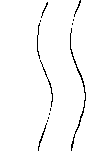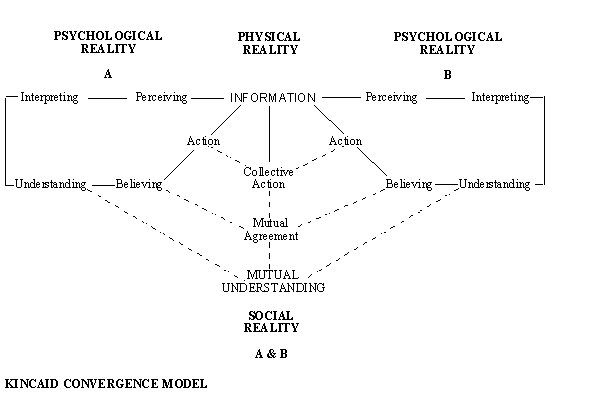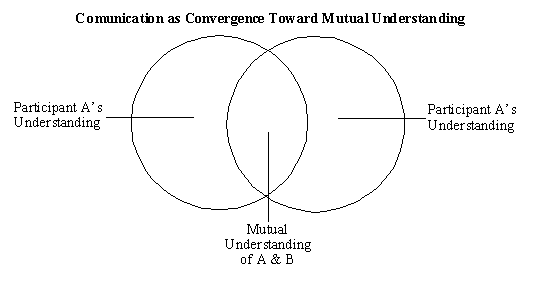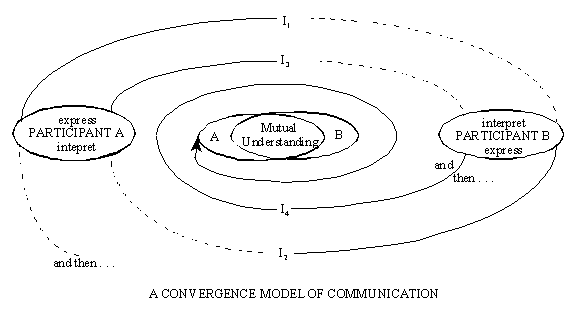
Seminar 2: Communication
Everyone predicted that there would be a man on the moon. This was a simple deduction from the old ScientificWorld View. No one predicted that everyone would be watching it on television. This required an understanding of the new communications revolution.
This seminar will discuss the idea of Communication and what it means to live in a world that we cannot control, but can communicate with.
Table of Contents
Perhaps the most controversial statement that I made in the last night was that there is no room in the old Scientific world view for communication. There are atoms and they move and they transfer energy, but they do not communicate.

Scientists are studying communication all the time. How can they do that if there is no room in the Scientific world view for it? The answer is that they recognize the phenomena, and they are trying to find the appropriate distortions that will allow them to cram it into the scientific world view.
What is communication and why is it such an unusual phenomenon?
Probably the most familiar model of communication is the one designed by Claud Shannon and Warren Weaver in their seminal book The Mathematical Theory of Communication.
Shannon (1964) comments:
"The fundamental problem of communication is that of reproducing at one point either exactly or approximately a message selected at another point. Frequently the messages have meaning; that is they refer to or are correlated according to some system with certain physical or conceptual entities." p.31
This is an extremely complicated diagram, and its implications are not immediately evident. It is, however, worth taking the time to examine, because its implications are revolutionary.
The diagram is a bit abstract and needs to be put in context. Shannon and Weaver were working for Bell Labs. In other words they were concerned with telephones. If you look at their model, you can easily see the telephone model behind it.

Putting the process in a diagram like this highlights some interesting things.
1. The use of code. The message has to be translated into a signal. The signal is a code for the message.
2. The reciprocal nature of communication. The transmitter and the receiver are two quite different processes. They are not the same. They are the inverse of each other. The transmitter puts the message into code and the receiver decodes it.
3. The harmonic nature of communication. "Reproducing at one point either exactly or approximately a message selected at another point" is creating a harmonic relationship.
If we take this model and apply it to a human conversation, we begin to see how complex an activity communication is.

The goal of human communication is to have the same meaning that is resonating in your mind harmonically resonating in the other person's mind. When we were doing parenting course we used to symbolize this by using two wavy lines.

In the old Scientific world view the object of any action was to transfer energy, to have an impact. Talking about your language having an impact is a metaphor and it is a particularly nasty metaphor. It assumes that language is some kind of particle stream. If you don't look very closely at the Shannon/Weaver model, you would think that the arrows were vectors and implied some kind of impact or force. Not only is the old Scientific world view inadequate for the description of communication, but trying to think of communication in terms of forces and impacts is destructive of actual communication.
There is an implication for this. Communication is a constant process of matching. To communicate with someone you have to begin where they are and then move to where you want to go, by a process of overlapping. One of my friends was a kindergarten teacher. She said that the secret to communicating with young children was to get down to their level, to literally, physically get down on the floor. To get a sympathetic response, you have to be sympathetic.
This is not just a matter of communicating with children. It is also a matter of communicating with adults. In fact it is even more important with adults. You have to begin where the person is at and then go from there. A large part of adult education is taking the time to find out where people are coming from. What do they know and what do they want to achieve. You can then design the experience for their level. A lock step approach is usually a waste of everyone's time.
Usually the hardest thing to understand is that your words and sentences do not have objective meaning, they are code. The person that you are speaking to could have a totally different meaning for the word. You say the word "red" and you think that it conveys a meaning. Last night I was playing a game where the pieces were color coded. Some players had difficulty distinguishing the colours. Was that pink or orange? Was that blue or green? This is why scientists hate and fear words. Eighty per cent of science is developing a set of words that have one meaning and one meaning only for the small group of scientists studying a particular subject. This is why scientists would much rather use mathematics, and algebraic equations. Equations seem so much more objective, so much less subject to interpretation.
Understanding communication as involving code allows us to talk about a range of subjects in terms of how information is encode. There is the neural code, binary code, DNA code, Body Language, and so on.
COMMUNICATION IS THE TRANSMISSION AND RECEPTION OF INFORMATION.
Although it is not obvious from the diagram, or the commentary, one of the main contributions that Claud Shannon made to the theory of communication was to define information. We will discuss that in the next session. For now the important point to note in the description of communication is that it is not the transmission of matter, nor is it the transmission of energy, it is the transmission of a message. Information can be transmitted.
One of the main reason for using code in communication is so that it can be adapted to the medium of communication. Thus the old telegraph systems was based on the Morse Code. Since the lines could transmit an electronic pulse, the code was made up of dots and dashes, a short pulse and a long pulse. This was enough to encode language. The development of the code was for the medium of telegraph. When the telephone was invented, it still used an electronic medium, but this time expressed as a wave. The computer uses binary code, because it is largely a giant collection of switches. The code used in the human body seems to have a variety of forms. There are electronic pulses. There are chemical messengers. There are even molecular messages. Most of these codes we are still translating.
Not immediately evident in Shannon's model is the extensive network that is involved in communication. The telephone way reproduce a message from one point to another, but it is also engaged in the process of sorting its way through a complex network of telephone lines in order to get from one specific person to another.
Shannon is a being a bit misleading when he says that the message may or may not have meaning. Meaning is the process of translation. Thus the meaning of the signal is the message. When the signal is decoded then we have its meaning. The meaning is the reference. The code the language, the message all refer to something else.
The classic exposition of this is done by the semanticists. The map is not the territory, but shares some formal characteristics of the territory.
Truth is matching. The message can be said to be true to the extent that the territory that it maps does share the same form as the message. If the map indicates that there is a hill where there is no hill then the map is false.
HOW THEN, DO YOU COMMUNICATE WITH A FOUR YEAR OLD?
First the bad news. You recognize that the four year old is a human being. He is self-controlled. There is not simple stimulus-response pattern. There is a process of interpretation at a four year old level on understanding, an evaluation at the level of a four year old's needs, and a selection of options from a four year old's collection of behaviours.
We would like the world to be predictable. We would like to know that any given action will have a predictable consequence. In dealing with physics and chemistry this is wonderfully linear. There is cause and effect. But in dealing with control systems this is not the case. There is no cause and effect. The behaviour of a control system is predictable only to the extent that you understand it's models, values and options.
The good news is that you can communicate. You are speaking in code and the four year old is speaking in code. But once you are on the same wave length, the communication will tend to harmonize.
The first definition of meaning that we used was the reference of the code. Thus the meaning of the telephone signal is the word that was spoken. The meaning of the word that was spoken is the experience of the person. The meaning of the experience is the event. A communication series can have a large number of translations or encodings. Each new code becomes the medium for the old code.
The second definition of meaning is that the meaning of your communication is the response that it generates. This is a pragmatic definition. Every time we generate a message, we get a response. The response can be expressed in body language, in verbal language, or in the lack of either. The response is the feedback that allows us to change our message and try a different option for communicating.
W. H. Auden expressed it this way,
A writer bears the responsibility for what he writes. If somebody says to him, 'I don't understand this passage', he can either say, 'It means just what it says, but since you seem rather stupid, I will put it in this way.' or 'I'm afraid you're right. As it stands, the passage doesn't say what I meant it to say. What I should have written is as follows.'
What is misleading about the Shannon/Weaver diagram is that it looks at only one event going in one direction. In fact most communication is a constant back and forth of approximate communication, that steadily becomes more effective. This is how feedback systems normally work. We try something out. See if it works. If it doesn't work, we try something different.
My brother-in-law used to do an exercise with the famous gestalt picture of the two women. Looked at one way the picture is the picture of a young woman looking away. Looked at another way the picture is the picture of an old woman looking towards you. About eighty percent of people see the young woman, twenty percent see the old woman, and a very small percentage see both. The group was then asked to come to an agreement on the age of the woman. Most groups after long arguments would finally agree that the woman was middle aged. When we communicate we are looking for harmony, for agreement.
Our effectiveness in the process of communication is a function primarily of our ability to listen. We usually think of effectiveness in communication as being able to express things in a variety of ways or in effective ways. Having options is important, but having a sense of what response you are getting is much more important.
The important revolution in grammar that Noam Chomsky brought about was to see language as generative. The remarkable thing about language is that people generate it. Language as pure imitation is very rare. We train people to memorize poems. If left to their own devices they would paraphrase it. Language is constructed by the person out of the building blocks of vocabulary, grammar, and transformations. People produce unique sentences that no one has ever spoken before.
The D. Lawrence Kincaid Convergence Model

In the book Communication Networks, Everett Rogers and Lawrence Kincaid present the above model of communication. They are attempting to combine the communications model of Shannon with the cybernetic model of Wiener.


The purpose of these diagrams was to deal with the objection that was raised to the Shannon model that it was too linear and did not reflect the interdependent nature of communication. Thus many researchers following the Shannon model did research around the question of what kind of message got what kind of response. In other words, it was easily absorbed into the psychological stimulus-response model.
One of the immediate problems about the Kincaid model is that it has an obvious error. It looks at Information as a physical reality. Information is not a physical reality. It exists in the form of physical reality. But the information is found in the difference between X and ~X, in the boundary between them. It is immaterial. It has no material reality.
For Rogers and Kincaid the problem was the problem of agreement. They wanted to show that communication was interactive and cooperative. But the same model can be used to develop divergence. In families the first born and the second born will strive to differentiate themselves. Whatever the first born is, the second born will be the opposite. Bateson observed this process of differentiation going on in South Sea Island communities and he called it "schismogenesis." If we go back to our basic Venn diagram, X or ~X, then we can see that the communication may not lead to convergence, but to the development of distinctions, differences, boundaries. A core distinction: American or Canadian, will lead to a set of sub-distinctions: Americans are greedy, crude, cruel, arrogant, etc. versus Canadians are generous, sophisticated, kind, humble, etc.
If we look closely at the Kincaid convergence model we see that it does not lead to convergence, but to the third way. Communication systems tend to create triads. We can see this in politics. During much of the 20th Century the battle was between communism and capitalism. Most governments settled on the middle ground, social democracy or a mixed economy. With the collapse of Communism in the Soviet Union the battle is now between capitalism and social democracy. The middle ground is some rather vague alternative called "the third way." As I understand it, it entails the privatization of some government services, and the elimination or reduction of some social programs.
Can a stone communicate? When the light reflected off a stone tells us something about the form of that stone is this a message? In what sense is the stone a transmitter? Clearly it absorbs some light waves and reflects others. It is a passive transmitter. It does the core communication act, it expresses itself.
When human beings use language to outer themselves, they are engaged in the same process of expressing themselves.
All communication is a form of translation. The common expression is true: it loses something in the translation. What it loses is context. Any given expression exists within a specific history, and a specific context. Translation takes it out of that context and history.
Much biblical criticism is designed to try to recreate as much as possible the historical context in which the texts were composed.
The complaint about the new media is concerned with this denuding of experience. It began with complaints about books in the eighteenth and nineteenth centuries. Books are now viewed as benign, and the media of television, and the Internet are viewed as dangerous. They are dangerous to the extent that they give us a distorted view of reality. Some distortion is inevitable, but as our technology becomes more and more powerful, it becomes more and more essential to have an undistorted view of reality. As our society becomes more and more democratic, it becomes more and more important that public information be undistorted.
One of the peculiarities of the television medium is that it claims for itself an unbiased position, that the old printed media did not claim. The print media used to have a point of view. One of the effects of television has been to encourage the print media to pretend to be unbiased.